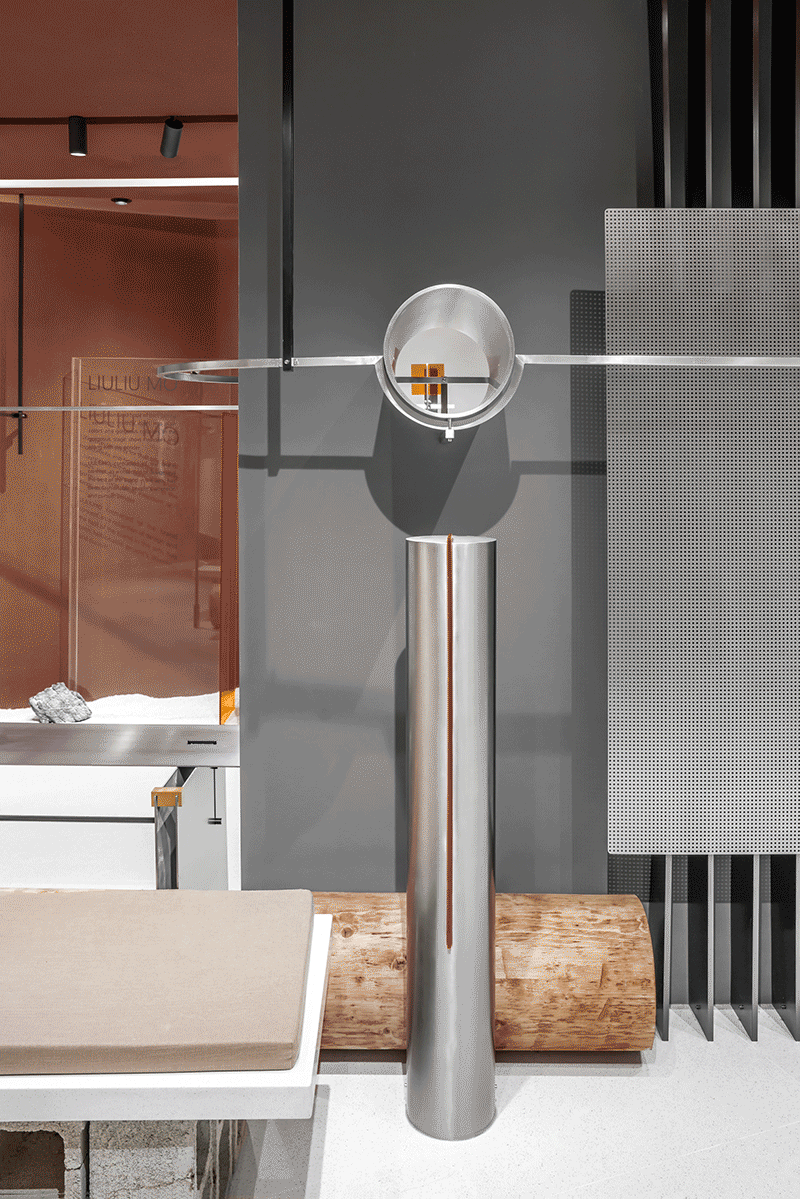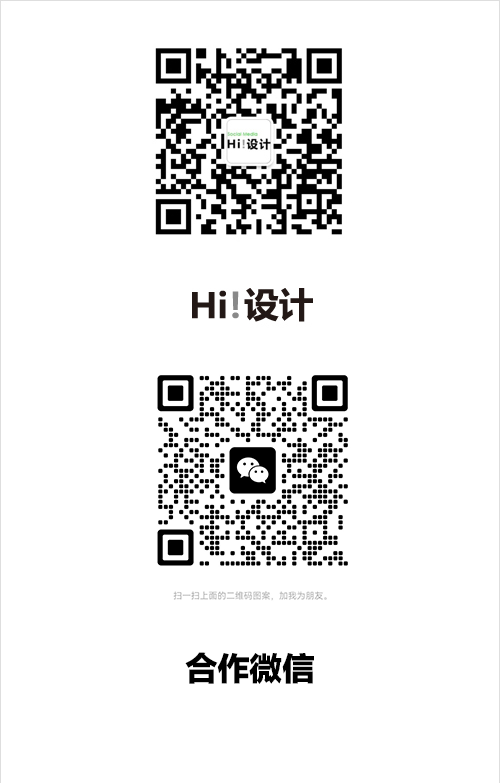服装与建筑的起源都是为了遮蔽和保护人类,一个有着流动之美,一个有着凝固之美,两者都是人类肌肤的延伸,都是关于人的艺术。作为一个新兴的本土独立设计师女装品牌,LIULIU MO(刘刘墨)在电商经济极其成熟的大环境中,希望将其“克制而极致”的时尚态度,融合进全新的实体店空间中。
The origin of clothing and architecture is to shield and protect human beings. One has the beauty of flow and the other has the beauty of solidification. Both are extensions of human skin and are all about human art. As an emerging local independent designer brand of womenswear, LIULIU MO hopes to integrate its “restraint but ultimate” fashion attitude into a new physical store in the environment of extremely mature e-commerce economy.
▲空间概览,entrance view
加减智库受邀为LIULIU MO品牌终端形象进行全面升级设计。广州万菱汇店作为其新形象落地的第一家店,加减智库试图在设计中,通过对“时尚”一词背后所隐藏的一些人类社会的反义关系的思考,寻求有别于传统商业空间的新的时尚表现形式。
PMT Partners was invited to carry out a comprehensive upgrade design for the LIULIU MO‘s all-new brand terminal. Designer tried to seek new fashion expressions different from the traditional commercial space by reflecting on the antonymy of human society behind the word “fashion”. As the first store with a new image in Guangzhou OneLink Walk Shopping Mall, PMT Partners sought new fashion expressions different from the traditional commercial space by reflecting on the antonymy of human society behind the word “fashion”.
▲陈列空间,display area
1.排料Marker Planning
▲空间的排料与秩序,spacial marker planning
▲空间中的排料,spatial marker planning
剖析服装与建筑这两个都拥有“人类肌肤延伸”社会属性的艺术类别,不难发现其背后总会存在许多相互冲突而又密切关联的词汇:工业与自然、机器与手工、私密与裸露、窥探与掩饰等等。这些人类社会“反义关联”的介质,可以看作是服装艺术和建筑艺术在创作上的“物料”,这些“物料”进而通过色彩、质感、造型等来表现每个个体的差异以及人类社会内部的构造。
Analyzing the two art categories of clothing and architecture that both have the social attributes of “human skin extension”, it is not difficult to find that there are always many conflicting but in fact closely linked words behind them: industrial and natural, mechanical and handmade, private and exposed, pried into and covered up“ and more. These media of “antisense association” of human society can be regarded as “materials” in the creation of clothing art and architectural art. These “materials” in turn express the individual differences and internal structure of human society through color, texture, and modeling.
▲材料的组合,combination of materials
▲材料的冲突与对话,conflict and dialogue of materials
2.裁缝The Tailor
▲空间中的一片式裁剪,“one-piece” tailoring in architectural space
▲空间的裁剪与服装的,spatial tailoring and fashion tailoring
设计抛弃传统服装商业空间对陈列展示的过度设计,在四边方正的90平米空间中,只以一面犹如布匹面料的流线型墙体,将门面展示、服饰展示、试衣间、储物间、收银柜台等所有功能整合串联起来,形成建筑空间中的“一片式剪裁”。 通过这样相对工业化的手段来塑造自然流线型的结构,是对功能布局的结构重组,由此也使得服装展销区域拥有更完整、纯粹的展示面,以获得更清晰高效的流线与更大的空间视觉效果。
This design abandoned the over-design in visual merchandising in the traditional commercial space of clothing business; instead, it integrated and connected front display, clothing display, fitting room, storage room, cashier and other functions by a streamlined wall. That can be seen as “one-piece” in architectural space. The natural streamlined structure is shaped by such a relatively industrialized method, it is a structural reorganization of the functional layout, which also makes the clothing display area have a more complete and pure display surface, so as to obtain a clearer and more efficient circulation and a larger visual effect.
▲红色真石漆天花,red natural-stone-paint ceiling
而在空间天花的处理上,本案大胆地使用了檀香红色真石漆,令商店得以在商场环境中脱颖而出,有效提高客人的进店率并对品牌形象留下深刻印象。
As for the ceilings, this design boldly used sandalwood red natural stone paint, which made the store stand out in the mall environment with black and white as the main color, impressing passers-by and greatly enhances passenger flow.
3.锁眼钉扣Buttonholing and Attaching
▲空间中的“开孔钉扣”,“buttonholing and bttaching” in space
服装制作中的锁眼钉扣是将纽扣等“零件”装配到衣服上并开孔的的过程。在本案的空间设计中,设计师用不锈钢、穿孔板、水泥空心砖等工业化材料作为空间陈列道具的“零部件”,以较为裸露直接的方式相互拼接组合,装配到空间中,并在道具与墙面交接的位置刻意切出孔洞,露出墙面内部红色真石漆的部分,从而放大这样一个工业化生产与装配过程。通过这样一个“开孔钉扣”的动作,设计师希望在不同材料交接细节之间,能留下某些关于人性场景的实验与“反义关联”的一些讨论和对话。
The buttonholing and attaching in clothing production is the process of assembling buttons and other parts to clothing and making holes. In this design, the designer used industrial materials such as stainless steel, perforated plates, and hollow concrete bricks as the “parts” of space display props. They were spliced and combined with each other in a relatively bare and direct way, assembled into the space. Holes were deliberately cut out at the interface of the props and wall’s surface, exposing the sandalwood red natural stone paint inside the wall, thereby magnifying such an industrialized production and assembly process. Through such a “buttonhole” action, the designer hopes that some experiments about human scenes and discussions about “antisense associations” will be left through the details of the meets of different materials.
▲服装和建筑在私密与窥探之间的人性矛盾和徘徊,humanity contradictions and lingering between privacy and spying on clothing and architecture
▲道具细部,details of props
墙上与中岛上的洞口,刚好满足人们在为自己挑选服饰时,不自觉往孔洞中窥探的心理尺度。
The holes on the wall and the central perfectly met consumers‘ psychological scale of unconscious snooping while picking clothing for themselves
90方的商业空间实践,不仅限于店铺本身,也不旨在寻求某一种特定的商业空间概念,而是希望通过这一的空间表达,引发对“新时尚”以及时尚背后所隐藏的社会关系的思考和讨论。
The purpose of this 90 square meters space practice is not intended to seek a specific concept of commercial space, but to lead to thinking and discussion about the “new fashion” and the hidden human relationships behind the fashion.
▲平面图,floor plan
项目信息——
项目名称:LIULIU MO服装店
设计公司:加减智库设计事务所
主持建筑师:曾喆,胡彦,赵炜昊,
设计团队:周紫月,卢泽强
空间摄影:曾喆
时尚摄影:刘少东
时装模特:刘畅
工程与道具顾问:易志雄,许伟加
建筑面积:90㎡
建成时间:2019
Project Information——
Project Name: LIULIU MO Fashion Retail
Deisgn Firm: PMT Partners Co., Ltd.
Principal Architects: ZENG zhe, HU yan, ZHAO Weihao
Design Team: ZHOU Ziyue, LU Zeqiang
Architectural Photography: ZENG zhe
Fashion Photography: Sherlock Lau
Fashoin Model: LIU Chang
Engineering & Props Consultant: YI Zhixiong, XU Weijia
Building Area: 90㎡
Completion Year: 2019

































